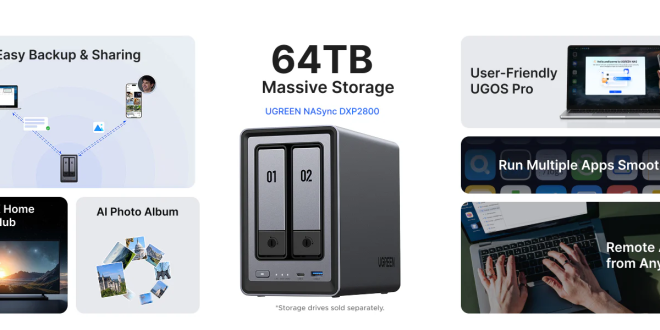NAS Storage, or Network Attached Storage, is a handy device for storing and sharing files at home or work. Home NAS systems are great for backups, media streaming, or file sharing, but slow read/write speeds can frustrate users. Faster speeds make file transfers quicker and streaming smoother. This blog shares 10 practical tips to improve your Home NAS performance, helping you get the most out of your NAS Storage setup.
Key Factors Affecting Home NAS Speed
Before jumping into fixes, it’s helpful to know what impacts NAS Storage speed. This section explains the main parts that affect how fast your Home NAS reads and writes data.
Hardware Components
Your Home NAS relies on its CPU, RAM, and hard drives. Weak hardware, like slow drives, can limit speed. For example, older hard drives struggle compared to modern ones.
Network Setup
The network connecting your Home NAS matters. Slow Wi-Fi or outdated Ethernet cables can bottleneck data transfers. A strong network setup is key for fast NAS Storage performance.
Software Settings
NAS Storage software, like firmware or file protocols, affects speed. Outdated settings or poor configurations can slow things down. Optimizing these can make a big difference.
10 Practical Tips to Speed Up NAS Storage
Now that you know what affects Home NAS speed, here are 10 tips to boost performance. These steps are easy to follow and can improve your NAS Storage efficiency.
Tip 1: Switch to Faster Hard Drives
Slow drives are a common issue for Home NAS systems. Upgrade to NAS-optimized drives, like WD Red or Seagate IronWolf. Solid-state drives (SSDs) are faster than traditional hard drives (HDDs) but cost more. Check your NAS Storage manual to ensure compatibility before buying.
Tip 2: Use SSD Caching
SSD caching uses a fast SSD to store frequently used files, speeding up access. Many Home NAS devices support this. Install an SSD, then enable caching in your NAS Storage settings. Choose a reliable SSD with enough capacity for your needs.
Tip 3: Choose the Right RAID Setup
RAID controls how your Home NAS stores data across drives. RAID 0 is fastest but risky, as one drive failure loses all data. RAID 5 or 10 balances speed and safety. Check your NAS Storage guide to pick and set up the best RAID for you.

Tip 4: Upgrade Your Network
A weak network slows down NAS Storage. Use Gigabit Ethernet (1GbE) or faster, like 2.5GbE. Replace old cables with Cat6 or Cat7. Ensure your router and switches support high speeds to match your Home NAS capabilities.
Tip 5: Set Up Link Aggregation
Link aggregation combines multiple Ethernet ports to increase NAS Storage bandwidth. If your Home NAS and switch support it, enable this in the NAS settings. It’s like adding lanes to a highway for faster data flow.
Tip 6: Keep Firmware Updated
Outdated firmware can slow your Home NAS. Manufacturers release updates to fix bugs and improve speed. Go to your NAS Storage admin panel, check for updates, and install them. Always back up data before updating to avoid issues.
Tip 7: Optimize File Systems and Protocols
Your Home NAS uses file systems like Btrfs or ext4. Btrfs is often faster for modern NAS Storage. Also, choose efficient protocols like SMB or NFS for file transfers. Adjust these in your NAS settings for better performance.
Tip 8: Limit Background Tasks
Backups or indexing can hog Home NAS resources, slowing read/write speeds. Schedule these tasks for off-hours, like overnight. Use your NAS Storage dashboard to monitor and pause heavy tasks during peak use.
Tip 9: Add More RAM
More RAM helps your Home NAS handle multiple tasks, boosting speed. Check your NAS Storage manual for compatible RAM types and limits. Adding 4GB or 8GB can make a noticeable difference for busy systems.
Tip 10: Monitor and Fix Issues
Regularly check your Home NAS performance to catch slowdowns. Tools like CrystalDiskMark test read/write speeds. If speeds drop, check drives, network, or settings. Fix issues like failing drives or network congestion promptly.
Applying Tips to Your Home NAS Setup
After learning these tips, it’s time to put them into action. This section helps you plan and apply changes to your NAS Storage for the best results.
Balance Cost and Speed
Some tips, like upgrading drives or RAM, cost money. Start with free fixes, like updating firmware or tweaking settings. For Home NAS users on a budget, prioritize high-impact changes like SSD caching.
Match Tips to Your Needs
Your Home NAS use affects which tips matter most. Media streamers might focus on network upgrades, while backup users prioritize RAID. Test speeds before and after changes to see what works.
Wrapping Up NAS Storage Optimization
Boosting your Home NAS read/write speed is within reach with these 10 tips. From upgrading drives to tweaking settings, each step can improve your NAS Storage performance. Start with one or two changes, test the results, and keep refining. A faster Home NAS means quicker file access and smoother streaming. Try these tips and share your results with other NAS Storage users!
Extra Resources for Home NAS Users
For more help, check your NAS Storage manufacturer’s website for setup guides. Tools like iperf can test network speed, and online forums offer tips from other Home NAS owners.
